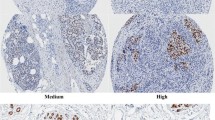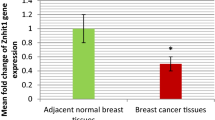Abstract
The transcription factor FOXA1 (forkhead box A1) plays key roles in tumor development and progression. In the present study, we analyzed the expression of FOXA1 in 52 breast tumors and 10 normal tissues, and investigated the relationship between FOXA1 and two EMT markers, namely Twist1 and E-cadherin by RT-PCR and IHC respectively. The expression level of FOXA1 was higher in tumor compared to normal tissues but the difference was not statistically significant (P = 0.138). FOXA1 expression correlated with less aggressive behavior as SBR grade I (P = 0.04), small tumors size (P = 0.05), and longer survival (P = 0.001). Furthermore, estrogen and progesterone positive tumors exhibit high level of FOXA1 (P = 0.002 and P = 0.038 respectively). Survival analysis showed that patients with ER positive/FOXA1 positive (P log rank = 0.001), PR positive/FOXA1 positive (P log rank = 0.044) and HER-2 negative/FOXA1 positive (P log rank = 0.002) tumors have a significant prolonged overall survival. On the other hand, the expression of E-cadherin positively correlated with FOXA1 (P = 0.028), whereas negative association was seen between the expression of Twist1 and FOXA1 (P = 0.016). Kaplan–Meier plots showed that patients with Twist1negative/FOXA1positive tumors have a significant prolonged overall survival (P log rank = 0.001) and FOXA1 appeared as independent predictors of patient survival in multivariate analyses. Overall, our results indicate that FOXA1 could be a useful biomarker to predict prognosis in breast cancer patients.






Similar content being viewed by others
References
Siegel RL, Miller KD, Jemal A (2017) CA: a cancer journal for clinicians. Cancer Stat 67:7–30. https://doi.org/10.3322/caac.21387
Ferlay J, Soerjomataram I, Ervik M, Dikshit R, Eser S, Mathers C, Rebelo M, Parkin DM, Forman D, Bray F (2015) Cancer incidence and mortality worldwide: sources methods and major patterns in GLOBOCAN in 2012. Int J Cancer 136:359–386. https://doi.org/10.1002/ijc.29210
Maalej M, Hentati D, Messai T, Kochbati L, El May A, Mrad K, Romdhane KB, Ben Abdallah M, Zouari B (2008) Breast cancer in Tunisia in 2004: a comparative clinical and epidemiological study. Bull Cancer 95:5–9. https://doi.org/10.1684/bdc.2008.0584
Parkin DM, Ferlay J, Hamdi-Cherif M, Sitas F, Thomas J, Wabinga H, Whelan SL (2003) Breast cancer in Africa: epidemiology and prevention. IARC Sci Publ Lyon Fr 153:262–267
Perou CM, Sorlie T, Eisen MB, van de Rijn M, Jeffrey SS, Rees CA, Pollack JR, Ross DT, Johnsen H, Akslen LA, Fluge O, Pergamenschikov A, Williams C, Zhu SX, Lonning PE, Borresen-Dale AL, Brown PO, Botstein D (2000) Molecular portraits of human breast tumours. Nature 406:747–752. https://doi.org/10.1038/35021093
Curtis C, Shah SP, Chin SF, Turashvili G, Rueda OM, Dunning MJ, Speed D, Lynch AG, Samarajiwa S, Yuan Y, Graf S, Ha G, Haffari G, Bashashati A, Russell R, McKinney S, METABRIC Group, Langerød A, Green A, Provenzano E, Wishart G, Pinder S, Watson P, Markowetz F, Murphy L, Ellis I, Purushotham A, Børresen-Dale AL, Brenton JD, Tavaré S, Caldas C, Aparicio S (2012) The genomic and transcriptomic architecture of 2,000 breast tumours reveals novel subgroups. Nature 486:346–352. https://doi.org/10.1038/nature10983
Eroles P, Bosch A, Perez-Fidalgo JA, Lluch A (2012) Molecular biology in breast cancer: intrinsic subtype and signaling pathways. Cancer Treat Rev 38:698–707. https://doi.org/10.1016/j.ctrv.2011.11.005
Mao XY, Lee MJ, Zhu J, Zhu C, Law SM, Snijders AM (2017) Genome-wide screen identifies a novel prognostic signature for breast cancer survival. Oncotarget 8:14003–14016. https://doi.org/10.18632/oncotarget.14776
Myatt SS, Lam EW (2007) The emerging roles of forkhead box (Fox) proteins in cancer. Nat Rev Cancer 7:847–859. https://doi.org/10.1038/nrc2223
Hurtado A, Holmes KA, Ross-Innes CS, Schmidt D, Carroll JS (2011) FOXA1 is a key determinant of estrogen receptor function and endocrine response. Nat Genet 43:27–33. https://doi.org/10.1038/ng.730
Bernardo M, Keri RA (2012) FOXA1: a transcription factor with parallel functions in development and cancer. Biosci Rep 32:113–130. https://doi.org/10.1158/1078-0432
Lin L, Miller CT, Contreras JI, Prescott MS, Dagenais SL, Wu R, Yee J, Orringer MB, Misek DE, Hanash SM, Glover TW, Beer DG (2002) The hepatocyte nuclear factor 3 alpha gene, HNF3alpha (FOXA1), on chromosome band 14q13 is amplified and overexpressed in esophageal and lung adenocarcinomas. Cancer Res 62:5273–5279
Mirosevich J, Gao N, Gupta A, Shappell SB, Jove R, Matusik RJ (2006) Expression and role of Foxa proteins inprostate cancer. Prostate 66:1013–1028. https://doi.org/10.1002/pros.20299
Nucera C, Eeckhoute J, Finn S, Carroll JS, Ligon AH, Priolo C, Fadda G, Toner M, Sheils O, Attard M, Pontecorvi A, Nose V, Loda M, Brown M (2009) FOXA1 is a potential oncogene in anaplastic thyroid carcinoma. Clin Cancer Res 15:3680–3689. https://doi.org/10.1017/S1462399409001008
Wang LL, Xiu YL, Chen X, Sun KX, Chen S, Wu DD, Liu BL, Zhao Y (2017) The transcription factor FOXA1 induces epithelial ovarian cancer tumorigenesis and progression. Tumour Biol. https://doi.org/10.1177/1010428317706210
Song Y, Washington MK, Crawford HC (2010) Loss of FOXA1/2 is essential for the epithelial-to-mesenchymal transition in pancreatic cancer. Cancer Res 70:2115–2125. https://doi.org/10.1158/0008-5472.can-09-2979
GuoW Keener AL, Jing Y, Cai L, Ai J, Zhang J, Fisher AL, Fu G, Wang Z (2015) FOXA1 modulates EAF2 regulation of AR transcriptional activity, cell proliferation, and migration in prostate cancer cells. Prostate 75:976–987. https://doi.org/10.1002/pros.22982
Badve S, Turbin D, Thorat MA, Morimiya A, Nielsen TO, Perou CM, Dunn S, Huntsman DG, Nakshatri H (2007) FOXA1 expression in breast cancer–correlation with luminal subtype A and survival. Clin Cancer Res 13:4415–4421. https://doi.org/10.1042/bsr20110046
Carroll JS, Liu XS, Brodsky AS, Li W, Meyer CA, Szary AJ, Eeckhoute J, Shao W, Hestermann EV, Geistlinger TR, Fox EA, Silver PA, Brown M (2005) Chromosome-wide mapping of estrogen receptor binding reveals long-range regulation requiring the forkhead protein FoxA1. Cell 122:33–43. https://doi.org/10.1016/j.cell.2005.05.008
Laganiere J, Deblois G, Lefebvre C, Bataille AR, Robert F, Giguere V (2005) From the cover: location analysis of estrogen receptor alpha target promoters reveals that FOXA1 defines a domain of the estrogen response. Proc Natl Acad Sci USA 102:11651–11656. https://doi.org/10.1073/pnas.0505575102
Fedele M, Cerchia L, Chiappetta G (2017) The epithelial-to-mesenchymal transition in breast cancer: focus on basal-like carcinomas. Cancers. https://doi.org/10.3390/cancers9100134
Zhu QQ, Ma C, Wang Q, Song Y, Lv T (2016) The role of TWIST1 in epithelial-mesenchymal transition and cancers. Tumour Biol 37:185–197. https://doi.org/10.1016/j.cell.2004.06.006
Xu Y, Qin L, Sun T, Wu H, He T, Ya Z, Mo Q, Liao L, Xu J (2017) Twist1 promotes breast cancer invasion and metastasis by silencing foxa1 expression. Oncogene 36:1157–1166. https://doi.org/10.1038/onc.2016.286
Fu J, Qin L, He T, Qin J, Hong J, Liao L, Xu J (2010) The TWIST/Mi2/NuRD protein complex and its essential role in cancer metastasis. Cell Res 21:275–289. https://doi.org/10.1038/cr.2010.118
Nakshatri H, Badve S (2009) FOXA1 in breast cancer. Exp Rev Mol Med. https://doi.org/10.1158/1078-0432.CCR-08-3155
Nakshatri H, Badve S (2009) FOXA1 in breast cancer. Exp Rev Mol Med. https://doi.org/10.1158/1078-0432.CCR-08-3155
Habashy HO, Powe DG, Rakha EA, Ball G, Paish C, Gee J, Nicholson RI, Ellis IO (2008) Forkhead-box A1 (FOXA1) expression in breast cancer and its prognostic significance. Eur J Cancer 44:1541–1551. https://doi.org/10.1016/j.ejca.2008.04.020
Thorat MA, Marchio C, Morimiya A, Savage K, Nakshatri H, Reis-Filho JS, Badve S (2008) Forkhead box A1 expression in breast cancer is associated with luminal subtype and good prognosis. J Clin Pathol 61:327–332. https://doi.org/10.1136/jcp.2007.052431
Horimoto Y, Arakawa A, Harada-Shoji N, Sonoue H, Yoshida Y, Himuro T (2015) Low FOXA1 expression predicts good response to neo-adjuvant chemotherapy resulting in good outcomes for luminal HER2-negative breast cancer cases. Br J Cancer 112:345–351. https://doi.org/10.1038/bjc.2014.595
Wolf I, Bose S, Williamson EA, Miller CW, Karlan BY, Koeffler HP (2007) FOXA1: growth inhibitor and a favorable prognostic factor in human breast cancer. Int N J Cancer 120:1013–1022. https://doi.org/10.1002/ijc.22389
Albergaria A, Paredes J, Sousa B, Milanezi F, Carneiro V, Bastos J, Costa S, Vieira D, Lopes N, Lam EW (2009) Expression of FOXA1 and GATA-3 in breast cancer: the prognostic significance in hormone receptor-negative tumours. Breast Cancer Res 11:40. https://doi.org/10.1186/bcr2327
Hisamatsu Y, Tokunaga E, Yamashita N, Akiyoshi S, Okada S, Nakashima Y, Aishima S, Morita M, Kakeji Y, Maehara Y (2012) Impact of FOXA1 expression on the prognosis of patients with hormone receptor-positive breast cancer. Ann Surg Oncol 19:1145–1152. https://doi.org/10.1245/s10434-011-2094-4
Hu Q, Luo Z, Xu T, Zhang JY, Zhu Y, Chen WX, Zhong SL, Zhao JH, Tang JH (2014) FOXA1: a promising prognostic marker in breast cancer. Asian Pac J Cancer Prev 15:11–16. https://doi.org/10.7314/APJCP.2014.15.1.11
He K, Zeng H, Xu X, Li A, Cai Q, Long X (2016) Clinicopathological significance of forkhead box protein A1 in breast cancer: a meta-analysis. Exper Ther Med 11:2525–2530. https://doi.org/10.3892/etm.2016.3229
Shou J, Lai Y, Xu J, Huang J (2016) Prognostic value of FOXA1 in breast cancer: a systematic review and meta-analysis. The Breast 27:35–43. https://doi.org/10.1016/j.breast.2016.02.009
Liu YN, Lee WW, Wang CY, Chao TH, Chen Y, Chen JH (2005) Regulatory mechanisms controlling human E-cadherin gene expression. Oncogene 24:8277–8290. https://doi.org/10.1038/sj.onc.1208991
Wijnhoven BP, Dinjens WN, Pignatelli M (2000) E-cadherin-catenin cell-cell adhesion complex and human cancer. Br J Surg 87:992–1005. https://doi.org/10.1046/j.1365-2168.2000.01513
Thiery JP (2002) Epithelial-mesenchymal transitions in tumour progression. Nat Rev Cancer 2:442–454. https://doi.org/10.1038/nrc822
Anzai E, Hirata K, Shibazaki M, Yamada C, Morii M, Honda T, Yamaguchi N, Yamaguchi N (2017) FOXA1 Induces E-Cadherin Expression at the Protein Level via Suppression of Slug in Epithelial Breast Cancer. Cells Biol Pharm Bull 40:1483–1489. https://doi.org/10.1248/bpb.b17-00307
Yang J, Mani SA, Donaher JL, Ramaswamy S, Itzykson RA, Come C, Savagner P, Gitelman I, Richardson A, Weinberg RA (2004) Twist, a master regulator of morphogenesis, plays an essential role in tumor metastasis. Cell 117:927–939. https://doi.org/10.1007/s13277-015-4450-7
Qin Q, Xu Y, He T, Qin C, Xu J (2012) Normal and disease-related biological functions of Twist1 and underlying molecular mechanisms. Cell Res 22:90–106. https://doi.org/10.1038/cr.2011.144
Gyorffy B, Lanczky A, Eklund AC, Denkert C, Budczies J, Li Q, Szallasi Z (2010) An online survival analysis tool to rapidly assess the effect of 22,277 genes on breast cancer prognosis using microarray data of 1,809 patients. Breast Cancer Res Treat 123:725–731. https://doi.org/10.1007/s10549-009-0674-9
Acknowledgements
Authors thank technicians at CHU Habib Bourguiba at Sfax—Tunisia for assistance in immunohistochemistry experiments.
Funding
This study was supported by a Grant of the Tunisian Ministry of High Education and Scientific Research (Grant No: LR15CBS02).
Author information
Authors and Affiliations
Contributions
DBG and EDB have conducted the experiments and analyzed the results. SC, AK, TSB analyzed the immunohistochemical slides and interpreted the results. WA, FT and RMG designed the work and helped in the interpretation of results. All the authors contributed to manuscript writing and approved it.
Corresponding author
Ethics declarations
Conflict of interest
Authors declare that they have no competing interests.
Ethical approval
The authors declare that the Institutional Ethics Committee of the CHU Habib Bourguiba of Sfax –Tunisia, approved this study which was conducted in agreement with the recommendations of the Helsinki Declaration.
Informed consent
Informed consent was obtained from patients included in the study.
Additional information
Publisher's Note
Springer Nature remains neutral with regard to jurisdictional claims in published maps and institutional affiliations.
Rights and permissions
About this article
Cite this article
BenAyed-Guerfali, D., Dabbèche-Bouricha, E., Ayadi, W. et al. Association of FOXA1 and EMT markers (Twist1 and E-cadherin) in breast cancer. Mol Biol Rep 46, 3247–3255 (2019). https://doi.org/10.1007/s11033-019-04784-w
Received:
Accepted:
Published:
Issue Date:
DOI: https://doi.org/10.1007/s11033-019-04784-w




